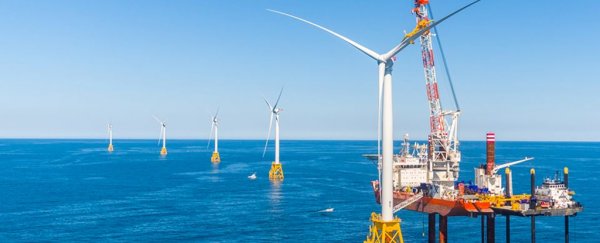The first offshore wind farm in the US will begin operations soon, with construction having just finished off the east coast of the continent, near Rhode Island.
While interest in offshore wind power is growing quickly around the world, the US has been slow to take advantage of this renewable energy source - until now. Once it's switched on in November, this new wind farm will contribute 30 megawatts to the grid - enough to power 17,000 homes.
The five-turbine Block Island Wind Farm cost US$300 million to build, and the project is being run by off-shore wind energy group, Deepwater Wind, in partnership with GE Renewable Energy; installation vessel provider, Fred. Olsen Windcarrier; and the state of Rhode Island.
"Projects like the Block Island Wind Farm are the future not only of Rhode Island's economy, but the whole country's economy," Rhode Island Governor Gina M. Raimondo announced last month.
So what's taken the US so long to get involved with wind power?
Well, it's complicated: a combination of regulatory hurdles and high costs to begin with, plus a reluctance from wealthy waterside residents to have their views obstructed by towering turbines.
But the six states of New England are showing strong uptake of renewables. Rhode Island and Vermont are now the only two states in the country that don't use any coal at all in their energy production, whereas in the United States as a whole, coal generated 39 percent of electricity in 2014.
The fact that the north-east coast has some of the stiffest offshore breezes and highest electricity demands also makes it ideal for the first US wind farm project to reach completion.
"Our untapped offshore wind energy potential is enormous and it holds the key to creating thousands of good paying clean energy careers, cleaning up the dangerous fossil fuel pollution endemic in many [of] our coastal cities, and provides another effective solution to addressing the climate crisis," Mary Anne Hitt from environmental organisation Sierra Club said in a statement.
The Block Island Wind Farm is an impressive feat of engineering. Each of the five turbines tower 100 metres (330 feet) above sea level, and feature three blades, each 73 metres (240 feet) long and weighing 24 tonnes.
What's more, no ship in the US is capable of installing turbines like this - another reason wind power has been slow to take off - so a Norwegian vessel called the Brave Tern travelled 5,310 kilometres (3,300 miles) across the Atlantic to do the job.
Even if the US is late to the offshore wind party, there's plenty of future potential to unlock. Local government estimates suggest that up to 4,000 gigawatts of power could be produced by wind farms off the coast of the nation, which is enough to meet the country's annual electricity needs four times over.
And best of all, the first offshore windfarm in the US won't be alone for long. As Justin Gillis reports for the New York Times, nearly two dozen similar projects are also on the drawing board.
This is the start of something, guys.
